Root Cause Analysis of Customer Complaints
VerifiedAdded on 2020/02/24
|8
|1341
|32
AI Summary
This assignment delves into the complexities of customer complaints within an electronic company by applying a comprehensive root cause analysis. It examines various complaint categories, pinpoints common underlying issues, and proposes effective solutions to address these concerns. The analysis utilizes distinct methodologies like event timeline establishment, change analysis, and barrier analysis to identify contributing factors and potential areas for improvement.
Contribute Materials
Your contribution can guide someone’s learning journey. Share your
documents today.
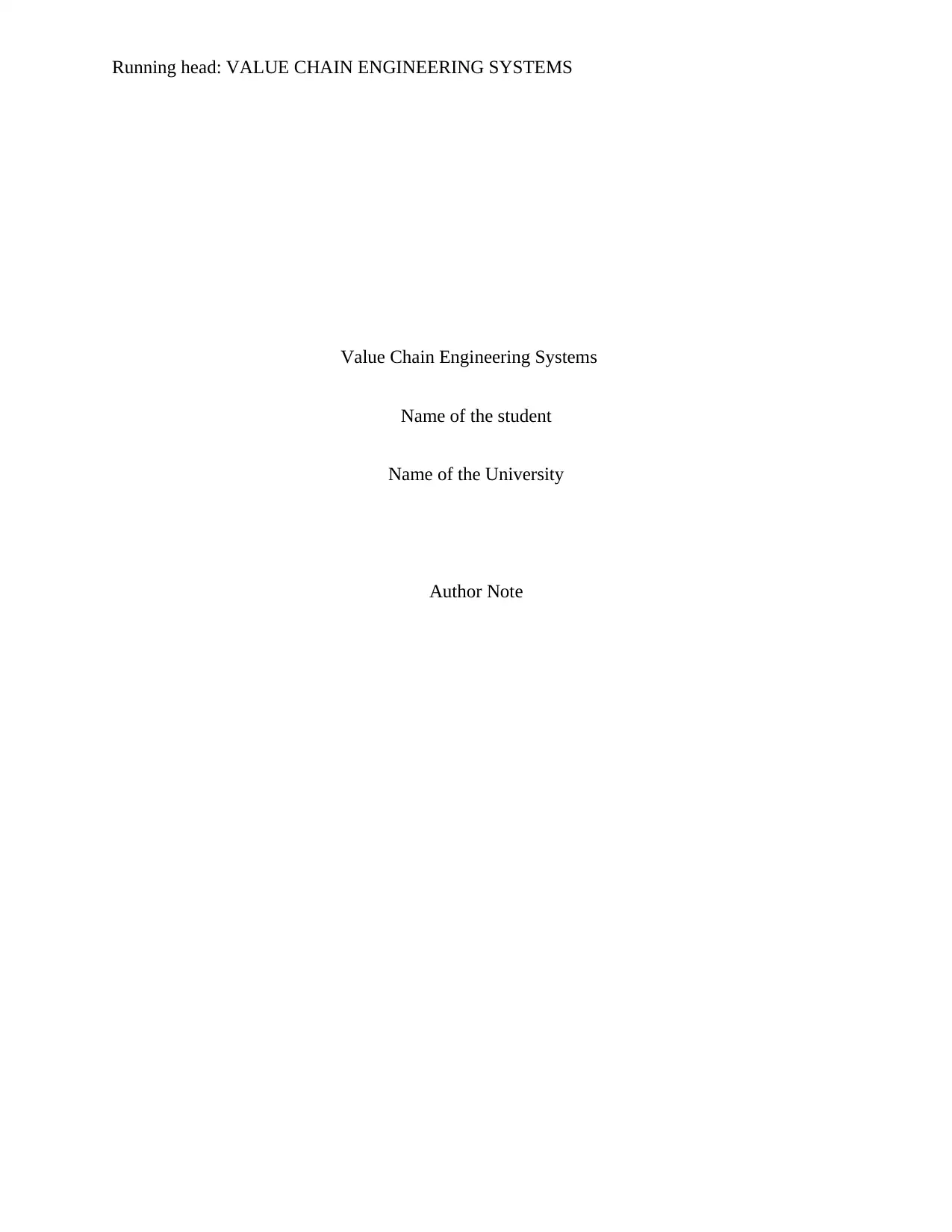
Running head: VALUE CHAIN ENGINEERING SYSTEMS
Value Chain Engineering Systems
Name of the student
Name of the University
Author Note
Value Chain Engineering Systems
Name of the student
Name of the University
Author Note
Secure Best Marks with AI Grader
Need help grading? Try our AI Grader for instant feedback on your assignments.
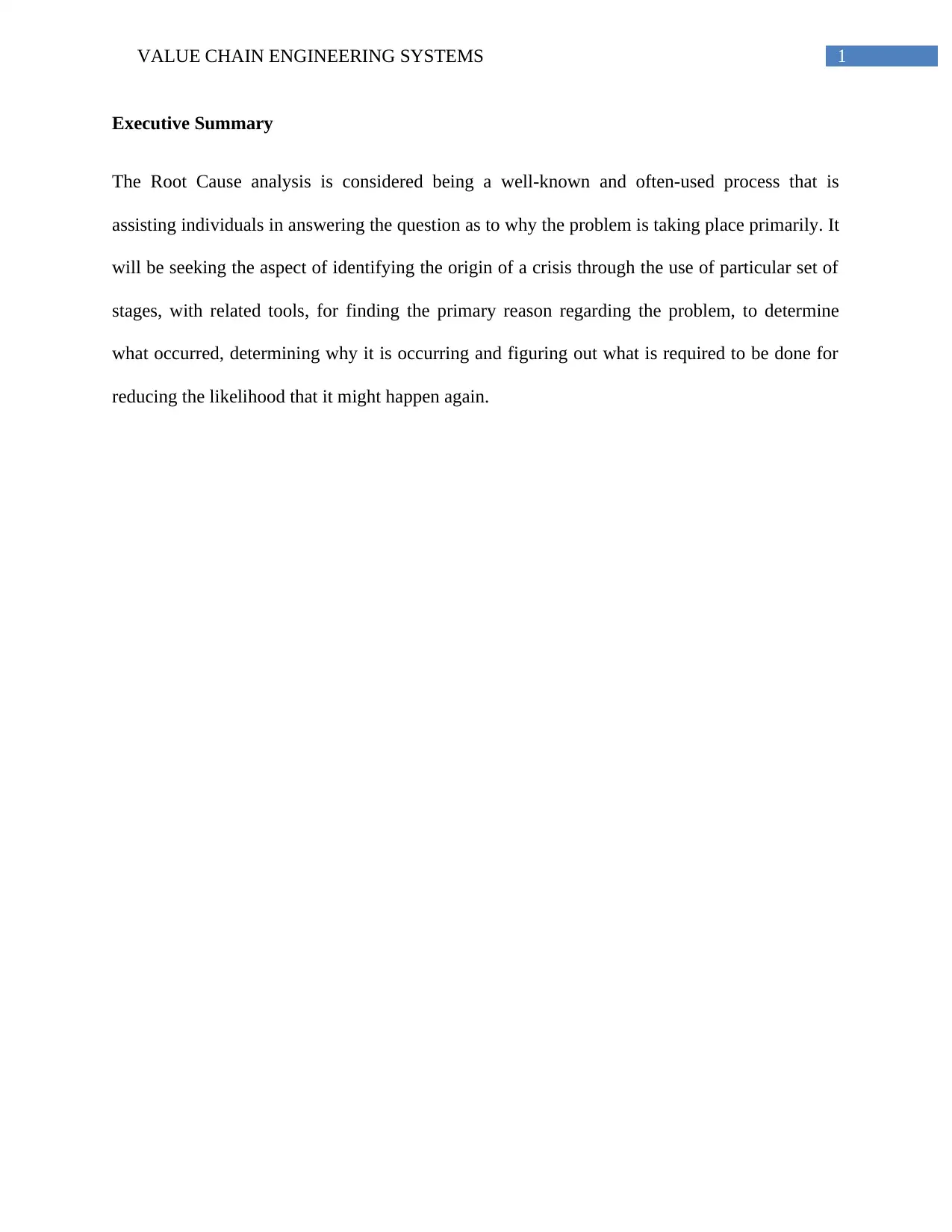
1VALUE CHAIN ENGINEERING SYSTEMS
Executive Summary
The Root Cause analysis is considered being a well-known and often-used process that is
assisting individuals in answering the question as to why the problem is taking place primarily. It
will be seeking the aspect of identifying the origin of a crisis through the use of particular set of
stages, with related tools, for finding the primary reason regarding the problem, to determine
what occurred, determining why it is occurring and figuring out what is required to be done for
reducing the likelihood that it might happen again.
Executive Summary
The Root Cause analysis is considered being a well-known and often-used process that is
assisting individuals in answering the question as to why the problem is taking place primarily. It
will be seeking the aspect of identifying the origin of a crisis through the use of particular set of
stages, with related tools, for finding the primary reason regarding the problem, to determine
what occurred, determining why it is occurring and figuring out what is required to be done for
reducing the likelihood that it might happen again.
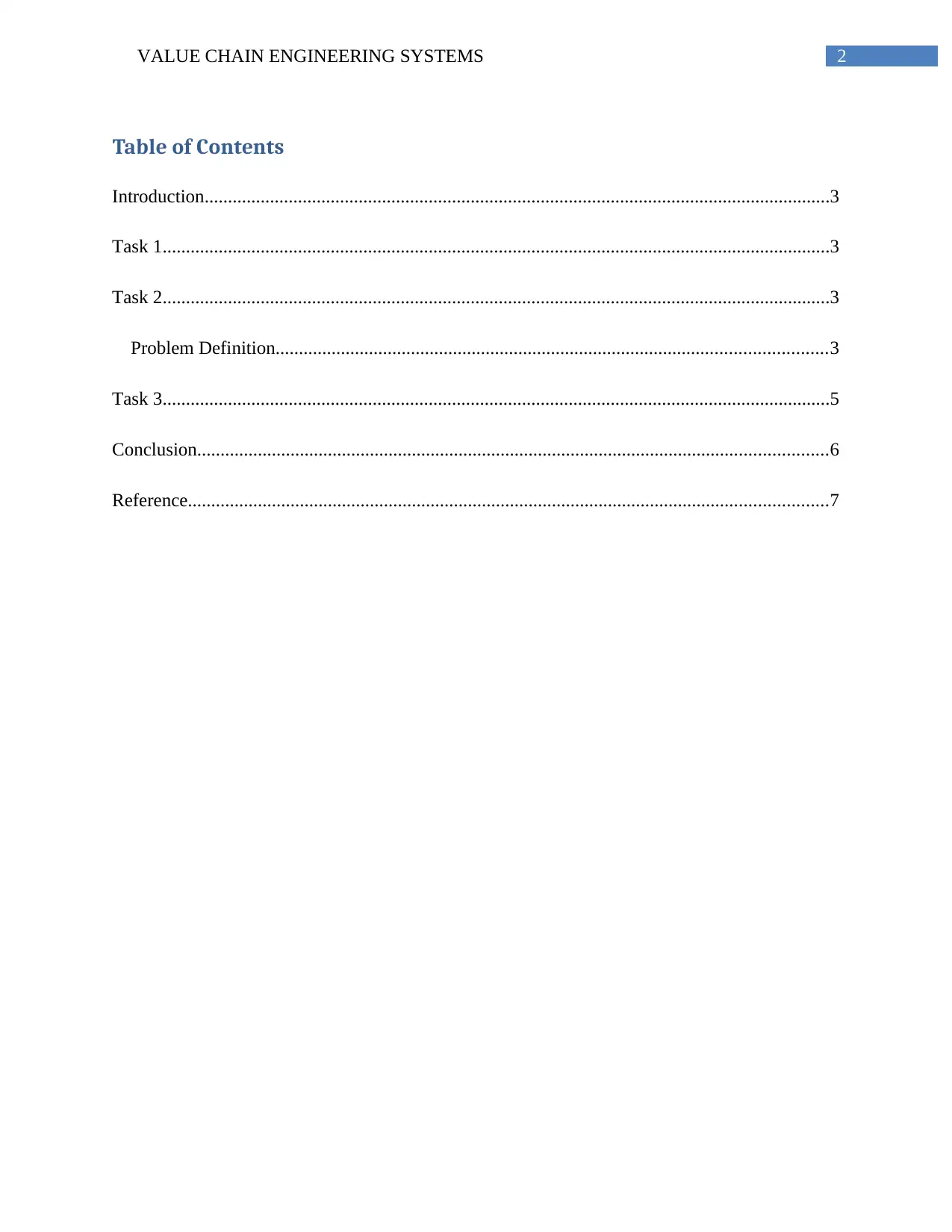
2VALUE CHAIN ENGINEERING SYSTEMS
Table of Contents
Introduction......................................................................................................................................3
Task 1...............................................................................................................................................3
Task 2...............................................................................................................................................3
Problem Definition......................................................................................................................3
Task 3...............................................................................................................................................5
Conclusion.......................................................................................................................................6
Reference.........................................................................................................................................7
Table of Contents
Introduction......................................................................................................................................3
Task 1...............................................................................................................................................3
Task 2...............................................................................................................................................3
Problem Definition......................................................................................................................3
Task 3...............................................................................................................................................5
Conclusion.......................................................................................................................................6
Reference.........................................................................................................................................7
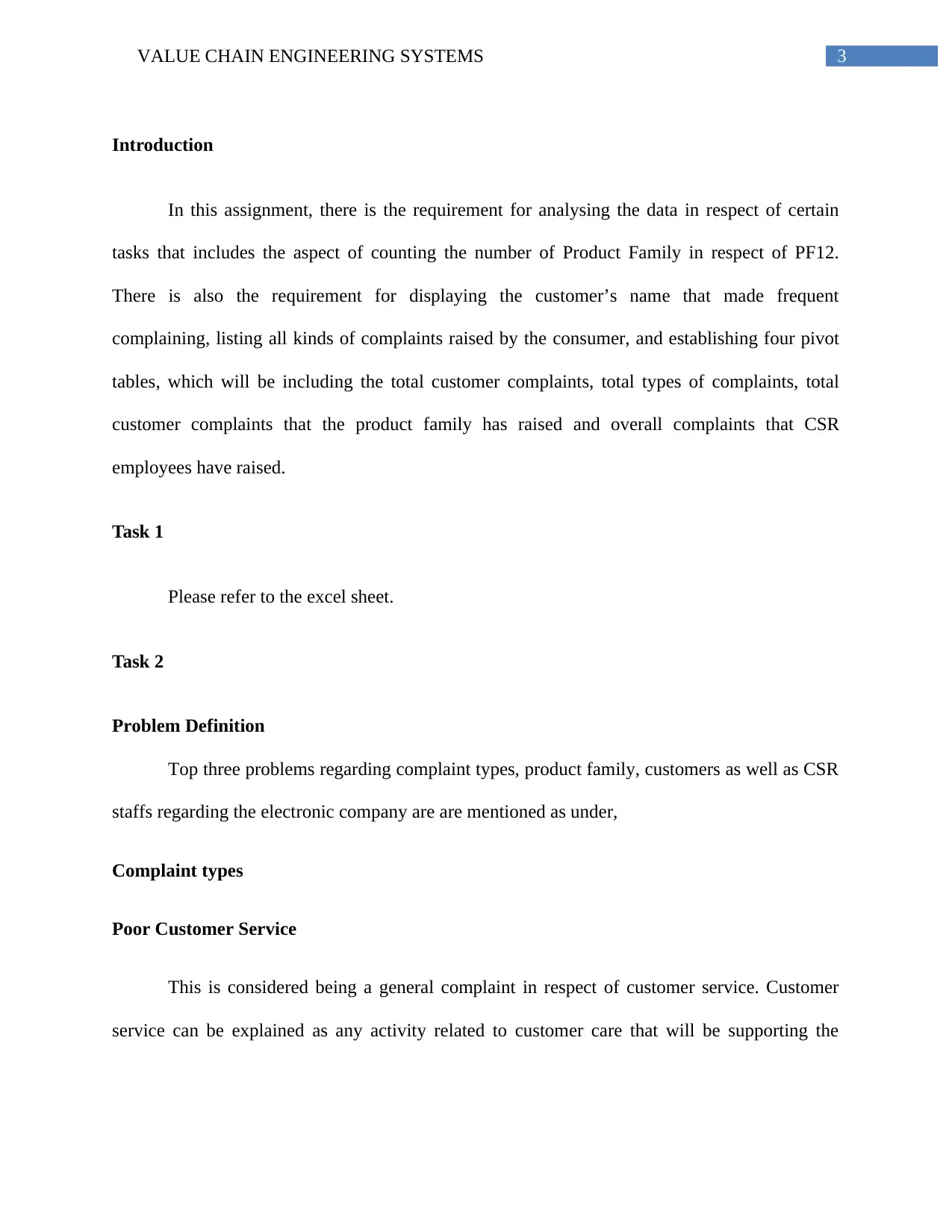
3VALUE CHAIN ENGINEERING SYSTEMS
Introduction
In this assignment, there is the requirement for analysing the data in respect of certain
tasks that includes the aspect of counting the number of Product Family in respect of PF12.
There is also the requirement for displaying the customer’s name that made frequent
complaining, listing all kinds of complaints raised by the consumer, and establishing four pivot
tables, which will be including the total customer complaints, total types of complaints, total
customer complaints that the product family has raised and overall complaints that CSR
employees have raised.
Task 1
Please refer to the excel sheet.
Task 2
Problem Definition
Top three problems regarding complaint types, product family, customers as well as CSR
staffs regarding the electronic company are are mentioned as under,
Complaint types
Poor Customer Service
This is considered being a general complaint in respect of customer service. Customer
service can be explained as any activity related to customer care that will be supporting the
Introduction
In this assignment, there is the requirement for analysing the data in respect of certain
tasks that includes the aspect of counting the number of Product Family in respect of PF12.
There is also the requirement for displaying the customer’s name that made frequent
complaining, listing all kinds of complaints raised by the consumer, and establishing four pivot
tables, which will be including the total customer complaints, total types of complaints, total
customer complaints that the product family has raised and overall complaints that CSR
employees have raised.
Task 1
Please refer to the excel sheet.
Task 2
Problem Definition
Top three problems regarding complaint types, product family, customers as well as CSR
staffs regarding the electronic company are are mentioned as under,
Complaint types
Poor Customer Service
This is considered being a general complaint in respect of customer service. Customer
service can be explained as any activity related to customer care that will be supporting the
Secure Best Marks with AI Grader
Need help grading? Try our AI Grader for instant feedback on your assignments.
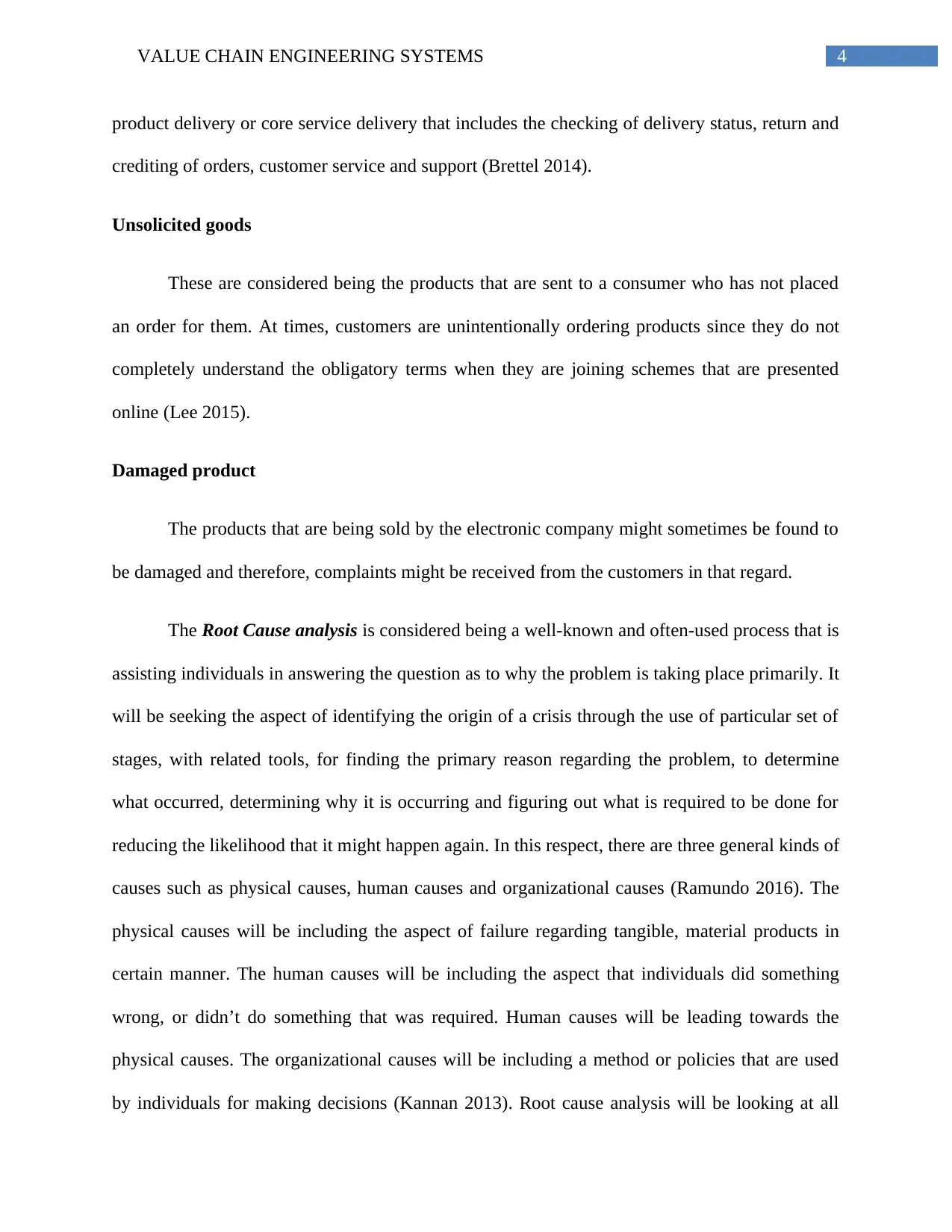
4VALUE CHAIN ENGINEERING SYSTEMS
product delivery or core service delivery that includes the checking of delivery status, return and
crediting of orders, customer service and support (Brettel 2014).
Unsolicited goods
These are considered being the products that are sent to a consumer who has not placed
an order for them. At times, customers are unintentionally ordering products since they do not
completely understand the obligatory terms when they are joining schemes that are presented
online (Lee 2015).
Damaged product
The products that are being sold by the electronic company might sometimes be found to
be damaged and therefore, complaints might be received from the customers in that regard.
The Root Cause analysis is considered being a well-known and often-used process that is
assisting individuals in answering the question as to why the problem is taking place primarily. It
will be seeking the aspect of identifying the origin of a crisis through the use of particular set of
stages, with related tools, for finding the primary reason regarding the problem, to determine
what occurred, determining why it is occurring and figuring out what is required to be done for
reducing the likelihood that it might happen again. In this respect, there are three general kinds of
causes such as physical causes, human causes and organizational causes (Ramundo 2016). The
physical causes will be including the aspect of failure regarding tangible, material products in
certain manner. The human causes will be including the aspect that individuals did something
wrong, or didn’t do something that was required. Human causes will be leading towards the
physical causes. The organizational causes will be including a method or policies that are used
by individuals for making decisions (Kannan 2013). Root cause analysis will be looking at all
product delivery or core service delivery that includes the checking of delivery status, return and
crediting of orders, customer service and support (Brettel 2014).
Unsolicited goods
These are considered being the products that are sent to a consumer who has not placed
an order for them. At times, customers are unintentionally ordering products since they do not
completely understand the obligatory terms when they are joining schemes that are presented
online (Lee 2015).
Damaged product
The products that are being sold by the electronic company might sometimes be found to
be damaged and therefore, complaints might be received from the customers in that regard.
The Root Cause analysis is considered being a well-known and often-used process that is
assisting individuals in answering the question as to why the problem is taking place primarily. It
will be seeking the aspect of identifying the origin of a crisis through the use of particular set of
stages, with related tools, for finding the primary reason regarding the problem, to determine
what occurred, determining why it is occurring and figuring out what is required to be done for
reducing the likelihood that it might happen again. In this respect, there are three general kinds of
causes such as physical causes, human causes and organizational causes (Ramundo 2016). The
physical causes will be including the aspect of failure regarding tangible, material products in
certain manner. The human causes will be including the aspect that individuals did something
wrong, or didn’t do something that was required. Human causes will be leading towards the
physical causes. The organizational causes will be including a method or policies that are used
by individuals for making decisions (Kannan 2013). Root cause analysis will be looking at all
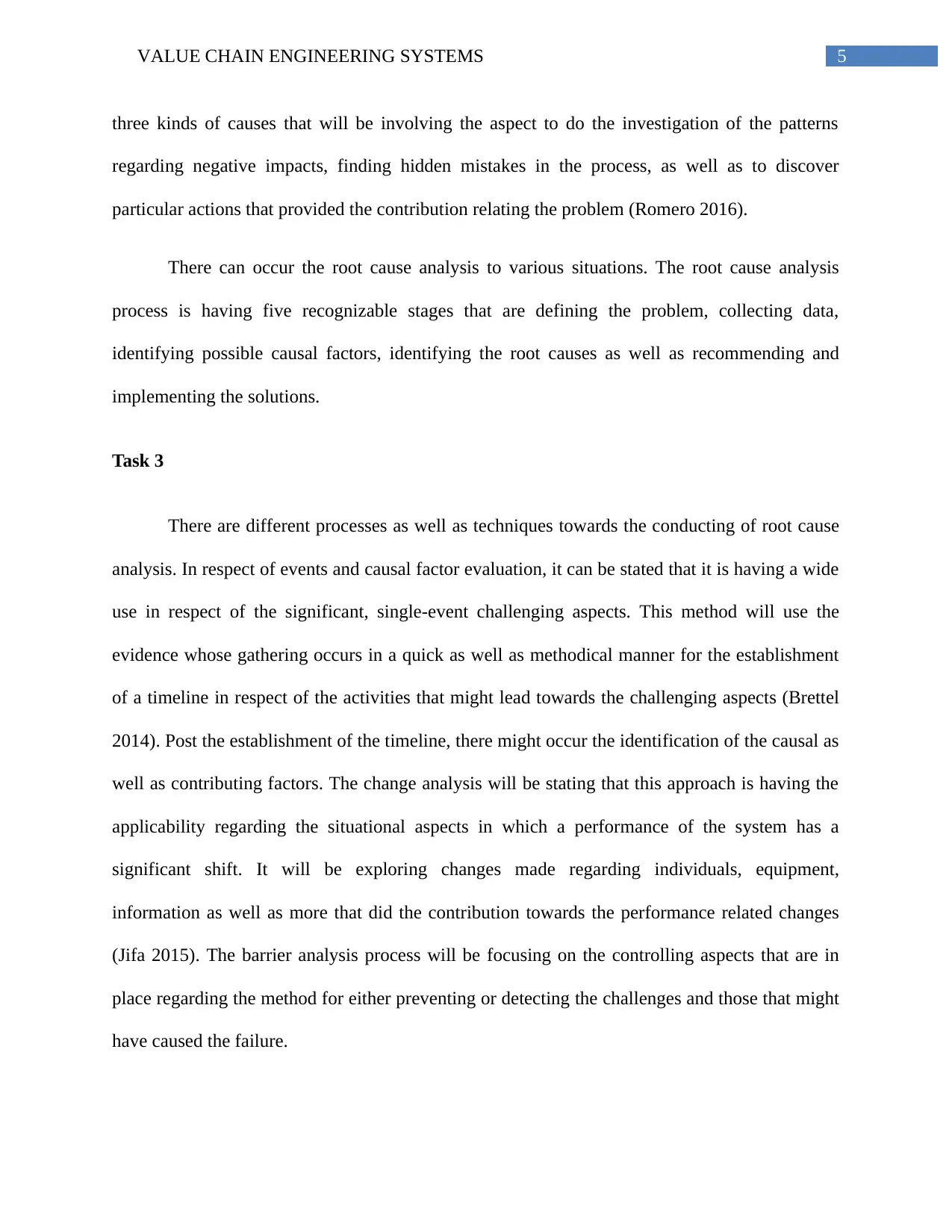
5VALUE CHAIN ENGINEERING SYSTEMS
three kinds of causes that will be involving the aspect to do the investigation of the patterns
regarding negative impacts, finding hidden mistakes in the process, as well as to discover
particular actions that provided the contribution relating the problem (Romero 2016).
There can occur the root cause analysis to various situations. The root cause analysis
process is having five recognizable stages that are defining the problem, collecting data,
identifying possible causal factors, identifying the root causes as well as recommending and
implementing the solutions.
Task 3
There are different processes as well as techniques towards the conducting of root cause
analysis. In respect of events and causal factor evaluation, it can be stated that it is having a wide
use in respect of the significant, single-event challenging aspects. This method will use the
evidence whose gathering occurs in a quick as well as methodical manner for the establishment
of a timeline in respect of the activities that might lead towards the challenging aspects (Brettel
2014). Post the establishment of the timeline, there might occur the identification of the causal as
well as contributing factors. The change analysis will be stating that this approach is having the
applicability regarding the situational aspects in which a performance of the system has a
significant shift. It will be exploring changes made regarding individuals, equipment,
information as well as more that did the contribution towards the performance related changes
(Jifa 2015). The barrier analysis process will be focusing on the controlling aspects that are in
place regarding the method for either preventing or detecting the challenges and those that might
have caused the failure.
three kinds of causes that will be involving the aspect to do the investigation of the patterns
regarding negative impacts, finding hidden mistakes in the process, as well as to discover
particular actions that provided the contribution relating the problem (Romero 2016).
There can occur the root cause analysis to various situations. The root cause analysis
process is having five recognizable stages that are defining the problem, collecting data,
identifying possible causal factors, identifying the root causes as well as recommending and
implementing the solutions.
Task 3
There are different processes as well as techniques towards the conducting of root cause
analysis. In respect of events and causal factor evaluation, it can be stated that it is having a wide
use in respect of the significant, single-event challenging aspects. This method will use the
evidence whose gathering occurs in a quick as well as methodical manner for the establishment
of a timeline in respect of the activities that might lead towards the challenging aspects (Brettel
2014). Post the establishment of the timeline, there might occur the identification of the causal as
well as contributing factors. The change analysis will be stating that this approach is having the
applicability regarding the situational aspects in which a performance of the system has a
significant shift. It will be exploring changes made regarding individuals, equipment,
information as well as more that did the contribution towards the performance related changes
(Jifa 2015). The barrier analysis process will be focusing on the controlling aspects that are in
place regarding the method for either preventing or detecting the challenges and those that might
have caused the failure.
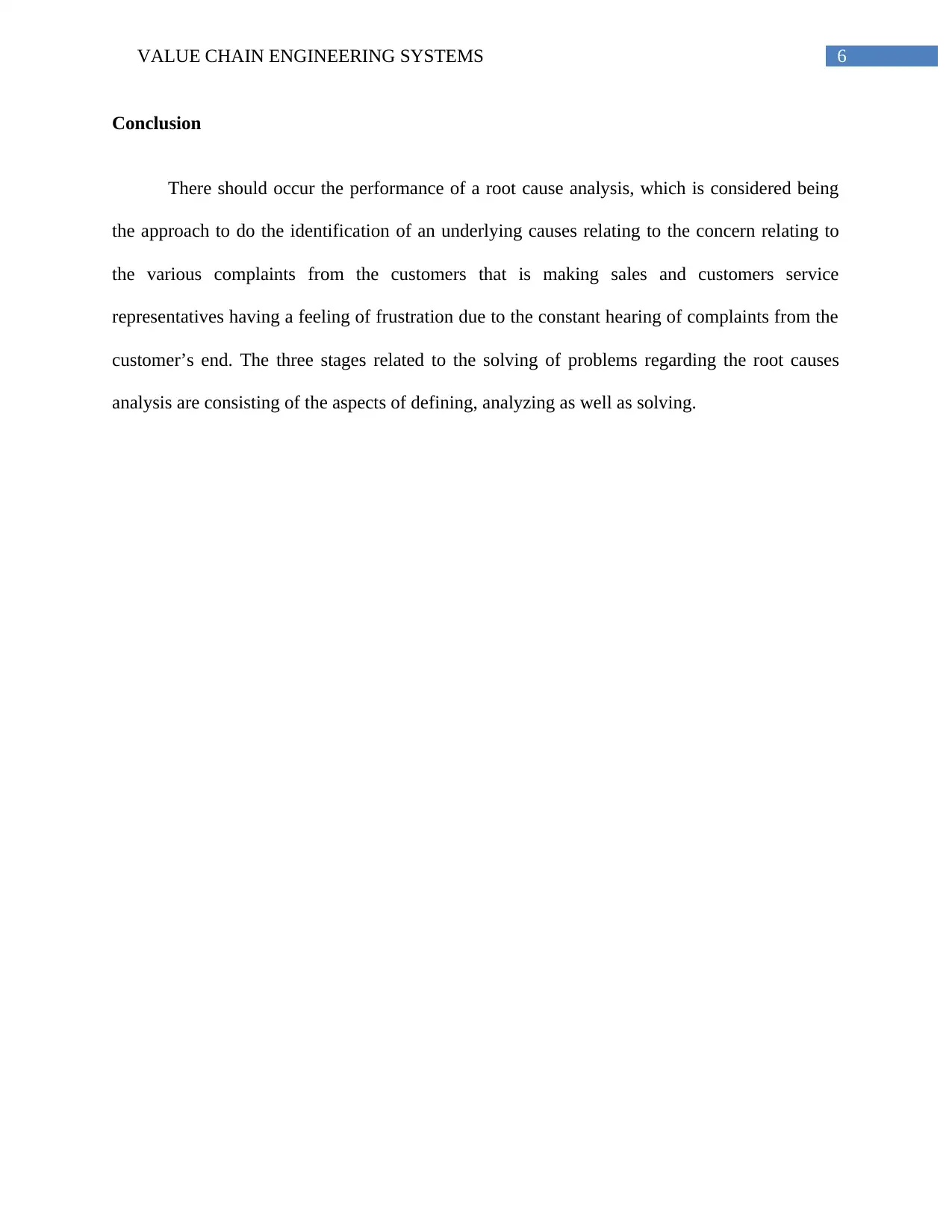
6VALUE CHAIN ENGINEERING SYSTEMS
Conclusion
There should occur the performance of a root cause analysis, which is considered being
the approach to do the identification of an underlying causes relating to the concern relating to
the various complaints from the customers that is making sales and customers service
representatives having a feeling of frustration due to the constant hearing of complaints from the
customer’s end. The three stages related to the solving of problems regarding the root causes
analysis are consisting of the aspects of defining, analyzing as well as solving.
Conclusion
There should occur the performance of a root cause analysis, which is considered being
the approach to do the identification of an underlying causes relating to the concern relating to
the various complaints from the customers that is making sales and customers service
representatives having a feeling of frustration due to the constant hearing of complaints from the
customer’s end. The three stages related to the solving of problems regarding the root causes
analysis are consisting of the aspects of defining, analyzing as well as solving.
Paraphrase This Document
Need a fresh take? Get an instant paraphrase of this document with our AI Paraphraser
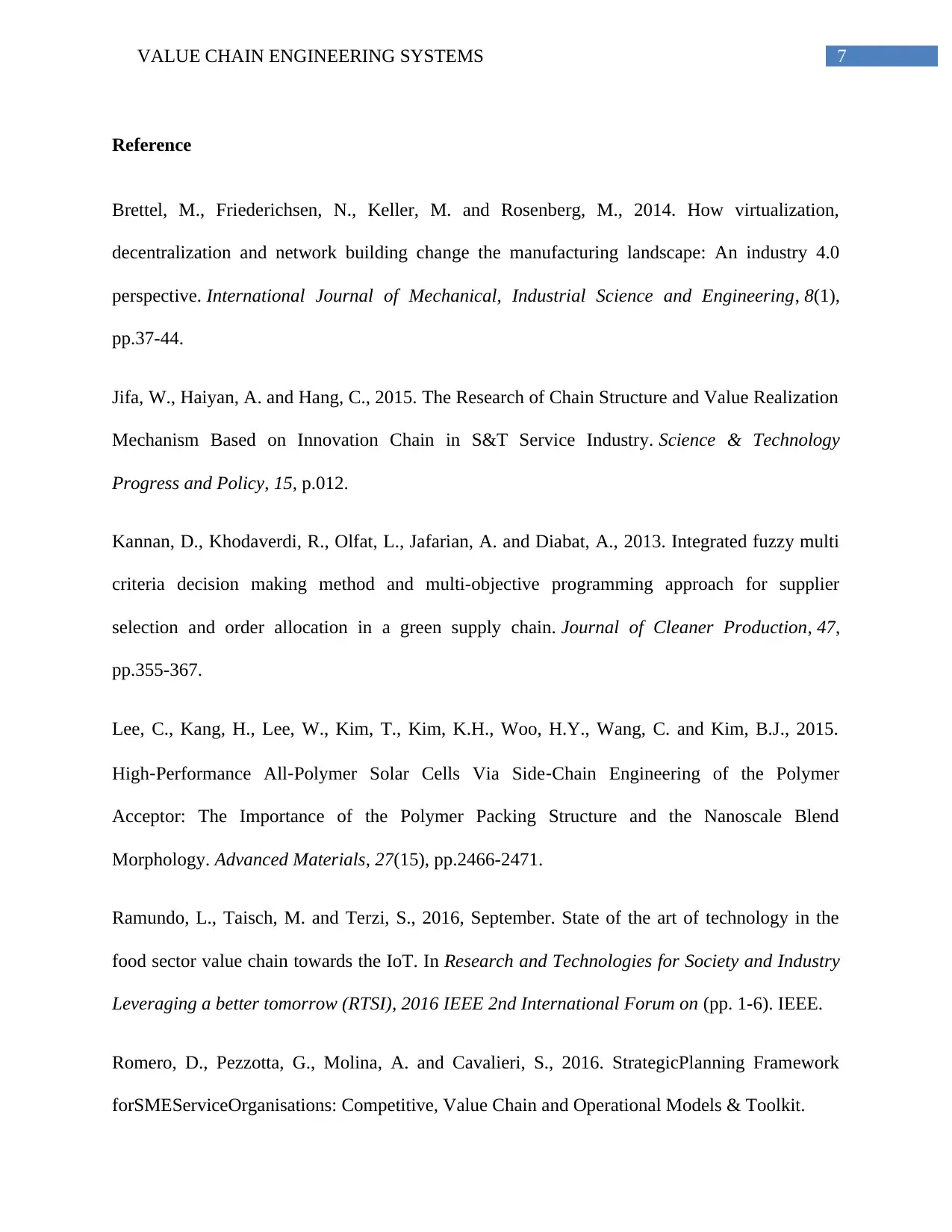
7VALUE CHAIN ENGINEERING SYSTEMS
Reference
Brettel, M., Friederichsen, N., Keller, M. and Rosenberg, M., 2014. How virtualization,
decentralization and network building change the manufacturing landscape: An industry 4.0
perspective. International Journal of Mechanical, Industrial Science and Engineering, 8(1),
pp.37-44.
Jifa, W., Haiyan, A. and Hang, C., 2015. The Research of Chain Structure and Value Realization
Mechanism Based on Innovation Chain in S&T Service Industry. Science & Technology
Progress and Policy, 15, p.012.
Kannan, D., Khodaverdi, R., Olfat, L., Jafarian, A. and Diabat, A., 2013. Integrated fuzzy multi
criteria decision making method and multi-objective programming approach for supplier
selection and order allocation in a green supply chain. Journal of Cleaner Production, 47,
pp.355-367.
Lee, C., Kang, H., Lee, W., Kim, T., Kim, K.H., Woo, H.Y., Wang, C. and Kim, B.J., 2015.
High‐Performance All‐Polymer Solar Cells Via Side‐Chain Engineering of the Polymer
Acceptor: The Importance of the Polymer Packing Structure and the Nanoscale Blend
Morphology. Advanced Materials, 27(15), pp.2466-2471.
Ramundo, L., Taisch, M. and Terzi, S., 2016, September. State of the art of technology in the
food sector value chain towards the IoT. In Research and Technologies for Society and Industry
Leveraging a better tomorrow (RTSI), 2016 IEEE 2nd International Forum on (pp. 1-6). IEEE.
Romero, D., Pezzotta, G., Molina, A. and Cavalieri, S., 2016. StrategicPlanning Framework
forSMEServiceOrganisations: Competitive, Value Chain and Operational Models & Toolkit.
Reference
Brettel, M., Friederichsen, N., Keller, M. and Rosenberg, M., 2014. How virtualization,
decentralization and network building change the manufacturing landscape: An industry 4.0
perspective. International Journal of Mechanical, Industrial Science and Engineering, 8(1),
pp.37-44.
Jifa, W., Haiyan, A. and Hang, C., 2015. The Research of Chain Structure and Value Realization
Mechanism Based on Innovation Chain in S&T Service Industry. Science & Technology
Progress and Policy, 15, p.012.
Kannan, D., Khodaverdi, R., Olfat, L., Jafarian, A. and Diabat, A., 2013. Integrated fuzzy multi
criteria decision making method and multi-objective programming approach for supplier
selection and order allocation in a green supply chain. Journal of Cleaner Production, 47,
pp.355-367.
Lee, C., Kang, H., Lee, W., Kim, T., Kim, K.H., Woo, H.Y., Wang, C. and Kim, B.J., 2015.
High‐Performance All‐Polymer Solar Cells Via Side‐Chain Engineering of the Polymer
Acceptor: The Importance of the Polymer Packing Structure and the Nanoscale Blend
Morphology. Advanced Materials, 27(15), pp.2466-2471.
Ramundo, L., Taisch, M. and Terzi, S., 2016, September. State of the art of technology in the
food sector value chain towards the IoT. In Research and Technologies for Society and Industry
Leveraging a better tomorrow (RTSI), 2016 IEEE 2nd International Forum on (pp. 1-6). IEEE.
Romero, D., Pezzotta, G., Molina, A. and Cavalieri, S., 2016. StrategicPlanning Framework
forSMEServiceOrganisations: Competitive, Value Chain and Operational Models & Toolkit.
1 out of 8
Related Documents
Your All-in-One AI-Powered Toolkit for Academic Success.
+13062052269
info@desklib.com
Available 24*7 on WhatsApp / Email
![[object Object]](/_next/static/media/star-bottom.7253800d.svg)
Unlock your academic potential
© 2024 | Zucol Services PVT LTD | All rights reserved.



